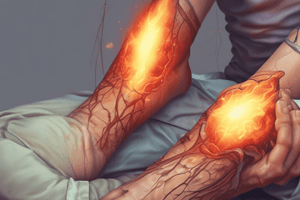Podcast
Questions and Answers
What is the primary cause of burns?
What is the primary cause of burns?
- Genetic disorders
- Infections
- Heat, radiation, electricity, friction, or contact with chemicals (correct)
- Cold temperatures
What is the most common type of burn injury?
What is the most common type of burn injury?
- Thermal burns (correct)
- Radiation burns
- Chemical burns
- Electrical burns
What is the goal of early excision and immediate physiological wound closure in burn wound management?
What is the goal of early excision and immediate physiological wound closure in burn wound management?
- To improve outcomes (correct)
- To prolong treatment
- To delay wound closure
- To cause scarring
What type of burn can cause minor superficial burns to severe internal injuries and even death?
What type of burn can cause minor superficial burns to severe internal injuries and even death?
What type of burn occurs when the skin or other tissues come into contact with corrosive or caustic substances?
What type of burn occurs when the skin or other tissues come into contact with corrosive or caustic substances?
What is the classification of burns that damage the deeper layers of the skin and sometimes the underlying tissue?
What is the classification of burns that damage the deeper layers of the skin and sometimes the underlying tissue?
What is the primary goal of first aid measures for chemical burns?
What is the primary goal of first aid measures for chemical burns?
Which degree of burn affects the epidermis, dermis, and fat layer?
Which degree of burn affects the epidermis, dermis, and fat layer?
What is the most severe degree of burn in terms of tissue loss?
What is the most severe degree of burn in terms of tissue loss?
What is the primary difference between second-degree and third-degree burns?
What is the primary difference between second-degree and third-degree burns?
Why is understanding burn classification important for healthcare professionals?
Why is understanding burn classification important for healthcare professionals?
Which of the following is NOT a characteristic of first-degree burns?
Which of the following is NOT a characteristic of first-degree burns?
Flashcards are hidden until you start studying
Study Notes
Burns: Understanding and Managing Various Types of Burn Injuries
Burns are a significant global health problem, causing an estimated 180,000 deaths annually. They are primarily caused by heat, radiation, electricity, friction, or contact with chemicals. This article will focus on different types of burns, their management, and the classification of burn degrees.
Thermal Burns
Thermal burns are the most common type of burn injury, occurring when the skin or other tissues are exposed to hot liquids, hot solids, or flames. They can range from superficial burns (first-degree burns) to severe burns (third-degree burns) that damage the deeper layers of the skin and sometimes the underlying tissue.
Burn Wound Management
The management of burn wounds involves several steps, including initial assessment, resuscitation, excision of the burn, and subsequent closure. Early excision and immediate physiological wound closure have been shown to improve outcomes.
Electrical Burns
Electrical burns occur when the body comes into contact with an electrical current. They can cause a range of injuries, from minor superficial burns to severe internal injuries and even death. Management includes identifying the source of the electrical current, providing first aid, and ensuring the patient receives appropriate medical care.
Chemical Burns
Chemical burns occur when the skin or other tissues come into contact with corrosive or caustic substances. They can cause a wide range of injuries, depending on the type and concentration of the chemical, the duration of exposure, and the area of the body affected. First aid measures include removing the chemical, cleansing the affected area, and seeking medical attention.
Burn Degrees Classification
Burns are classified into six degrees, with each degree representing increasing severity. The classification is as follows:
- First-degree burns: Affect only the outer layer of the skin (epidermis) and cause redness, pain, and mild swelling.
- Second-degree burns: Affect the epidermis and the underlying layer of skin (dermis), causing blisters, severe pain, and swelling.
- Third-degree burns: Affect the epidermis, dermis, and fat layer (subcutaneous tissue), leading to charred, dry, and leathery skin.
- Fourth-degree burns: Involve the muscles and bone underneath the skin, causing severe damage and extensive tissue loss.
- Fifth-degree burns: Involve the muscle and bone, and may involve organs and bones.
- Sixth-degree burns: Involve total tissue loss, including the bone.
In conclusion, burns are a complex and diverse group of injuries that require specialized care and management. Understanding the different types of burns and their classification can help healthcare professionals provide appropriate care and improve outcomes for patients.
Studying That Suits You
Use AI to generate personalized quizzes and flashcards to suit your learning preferences.




